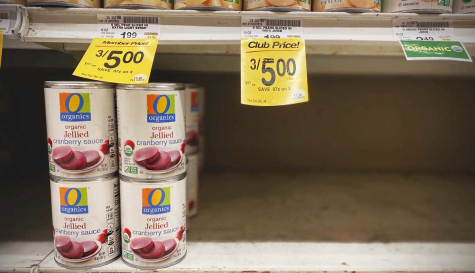
Twitter: Annabelchiaa
November 8, 2021
The 2021 Thanksgiving feast will take a massive bite out of consumers’ wallets. In preparation for the annual feast, the labor constraints wiping out the Thanksgiving staples, as well as the rising prices of turkeys, are just a few of the culprits of the hefty holiday spendings.
The price of Thanksgiving is going to be significantly higher this year than it was last year
— Trey Malone
“The price of Thanksgiving is going to be significantly higher this year than it was last year,” Trey Malone, an agricultural economist at Michigan State University, said.
Compared to the previous year, shopping for the yearly feast will be a completely different experience. According to a farm bureau survey, the prices of Thanksgiving feasts significantly decreased 4% during the previous year due to smaller gatherings induced by the constraints of the pandemic. This year, experts anticipate Thanksgiving feasts to be considerably more extensive as a result of fewer restrictions. Still, the leftover economic consequences from COVID-19 are likely to have effects on Thanksgiving this year.
“There are strange ripple effects are caused by Covid that affected the supply and demand. We still have a massive disruption in the economy, and we have to work through those problems,” Malone said.
Labor shortages leftover from the pandemic lead to a lower number of products accessible in retailers creating a challenge for customers. When fewer workers are available to stock the shelves, businesses distribute less goods.
“There are labor constraints all along with the supply change. With that constraint, we’ve seen stockouts or shortages,” Malone said.
The higher demand of people buying Thanksgiving foods for the feasts and the stockouts ultimately raise product prices. The demand changes further affect food production companies that are frantically keeping up with the rising prices of ingredients. According to an IRI index report, the data shows a waning amount of food stock available, and recent trends display supplies dropping from numbers ranging between 6% to 10%.
In addition to the workers who produce food and grocery store operators, the leftover labor concerns from the pandemic extend to other factors beyond the food industry that affect consumers.
“With labor shortages, we also have trucking issues. To drive a large truck to help transport goods, the driver will need a CDL license, but there has been a shortage of CDL licenses,” Malone said.
The deficiency of Commercial Driving Licenses (CDL) presents considerable difficulties when tasked with finding ways to transport the goods—the ultimate effect; higher shipping costs for produce, which are passed on to consumers.
Problems with labor and transportation directly contribute to the rising prices, but there are minor culprits that consumers may not have even thought about that still contribute to the increasing costs in grocery stores. Overlooked factors include the rising prices of the display and transportation materials.
“Pallet prices are also extremely high right now; a price you may not think about but was passed on to food products,” Malone said.
Farmers need pallets and transportation containers to move their items from the fields to the trucks, and those same containers make their way to the supermarkets alongside the food products. When compared to the stockouts themselves, rising prices and a lack of transportation equipment are overlooked as the primary causes of food price increases, but they still matter once the receipts are scanned.
The supply chain issues currently exist as a spider web of different problems, and various portions tangled together ultimately produce negative consequences for consumers.
The largest impact on the price of a traditional Thanksgiving meal this year will be its staple, Turkey. Arguably, the most famous dish seen at tables is the thanksgiving turkey, a product currently being affected by rising meat prices.
Pape Meat Co, a local poultry business, had noticed several changes regarding their turkey supplies this year. They have seen a considerable increase in demand for turkey compared to 2020 leading to increased prices.
“[Turkey] prices have gone up about 30 cents per pound,” Brian Gilbert, a worker at Pape Meat Co, said.
There’s a complex tangle of economic issues that factor into the rising prices of turkeys, including the more expensive costs used to grow the turkeys from the last year.
“There’s no single answer, but higher corn and soybean prices mean higher feed costs for turkeys,” Professor Jayson Lusk, an economist professor from Purdue University, said.
Lusk estimated a 10% increase in the prices of turkey compared to last year’s prices. Besides the rising costs of the turkey feed, he notes that the bird prices reflect adverse weather conditions around the globe, such as in agricultural regions as far as in Brazil. The difficult weather conditions make it harder for turkeys to be raised properly to meet the demands of the buyers, adding another price tag to the expounding bill.
In addition to turkey, staples at the Thanksgiving table include but are not limited to cranberry sauces, pumpkin pie, and gravy sauce. All these dishes have one thing in common; a component of each frequently requires canned goods to create.
Unfortunately for Thanksgiving enthusiasts, numerous factors contribute to the soaring prices of preserved goods.
“A lot of people stocked up on canned foods over the last year because they keep a long time on the shelf. So suppliers need to make more to keep up,” Zoë Plakias, a Ph.D. economist at Ohio State University, said.
Shortages concerning canned goods aren’t caused by labor issues, however, but instead by consumer frenzies from the pandemic. Although a year has passed since panicked buyers frantically cleared out grocery stores during the initial stage of the pandemic, there are still lasting effects that carry into the current year.

Canned goods are packaged with aluminum and steel, and these materials prices have recently skyrocketed in light of both the pandemic and other outside factors.
“It takes a lot of energy to produce aluminum, and energy prices have increased a lot this year relative to last year when they were very low, so these prices and enhanced environmental regulations in China are leading [them] to cut back on production,” Plakias said.
The country of China and its industries are significant producers of energy sources that are globally used. When the government imposed restrictions on steel and aluminum plants, massive price increases were created, affecting the prices of canned goods worldwide.
Despite all the supply chain issues, Plakias notes that it’s crucial to address that food is not running out in the United States and that the lack of a couple of items doesn’t constitute a complete desolation of food availability. Rather, it’s advised for people to be considerate and buy only what they need in preparation for the feast.
“Stepping into the holiday season, the best advice is to be mindful really plan ahead when buying your stuff,” Malone said.
